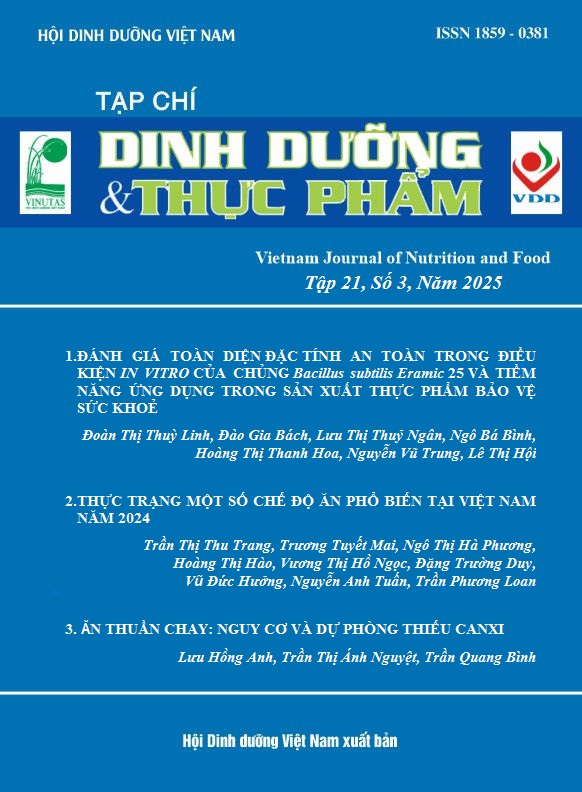SELECTION OF AMYLASE-PRODUCING MOLDS FROM Com Ruou (SWEET FERMENTED GLUTINOUS RICE) AS A POTENTIAL CANDIDATE FOR ENZYME INDUSTRY
Main Article Content
Abstract
Aims: This study aims to isolate and evaluate the amylase enzyme biosynthesic capability of fungal strains derived from Com Ruou (Sweet fermented glutinous rice).
Methods: The research involves the initial isolation and screening of fungal strains for their ability to degrade starch through the formation of clear zones around colonies using starch agar and iodine solution. Potential strains were subsequently cultured in a starch liquid medium to assess amylase enzyme activity. The strain with the highest amylase biosynthesis was identified using molecular biology techniques.
Results: A total of 14 fungal strains were isolated and analyzed for morphological characteristics, microscopic observation, and starch degradation capability. Results indicated that the strain CRBK1 exhibited the highest amylase activity, reaching approximately 70% and 3.5 U/mL, significantly surpassing the other strains. ITS rDNA sequencing identified CRBK1 as belonging to the species Rhizopus arrhizus, with over 96% similarity to strains in the GenBank database.
Conclusion: This research highlights the potential for utilizing indigenous fungal sources for amylase enzyme production. Future research will focus on optimizing fermentation processes, improving the purification of amylase from Rhizopus arrhizus, and assessing the enzyme's stability in food industry and bioenergy applications.
Keywords
Com ruou, amylase enzyme, starch degradation, Rhizopus arrhizus
Article Details
References
2. Dung NTP, Rombouts FM, Nout MJR. Characteristics of some traditional Vietnamese starch-based rice wine fermentation starters (men). LWT - Food Science and Technology. 2007;40 (1):130-135.
3. Lennartsson PR, Taherzadeh MJ, Edebo L. Rhizopus. In Encyclopedia of Food Microbiology, edited by Batt CA and Tortorello ML. 2014:284-290. Oxford, Academic Press.
4. Nguyễn Huy Thuần, Lê Thị Hạnh, Trần Đăng Khánh, Nguyễn Văn Giang. Đặc điểm sinh học của một số chủng nấm mốc phân lập từ bánh men rượu Thanh Hóa. Tạp chí Khoa học Nông nghiệp Việt Nam. 2021;19 (3):322-330.
5. Beltagy EA, Abouelwafa A, Barakat KM. Bioethanol production from immobilized amylase produced by marine Aspergillus flavus AUMC10636. Egyptian Journal of Aquatic Research. 2022;48 (4):325-331.
6. Saleem A, Ebrahim MKH. Production of amylase by fungi isolated from legume seeds collected in Almadinah Almunawwarah, Saudi Arabia. Journal of Taibah University for Science. 2014;8 (2):90-97.
7. Constantine J. Alexopoulos CWM, Meredith M. Introductory Mycology. Wiley India Pvt. Limited. 2007.
8. Ogbonna J, Ominyi M, Nwoba E, Ge, Nwagu K, Ke, R U. Isolation of alpha amylase and glucoamylase producing fungi and their application in bioethanol production. International Journal of Science and Nature. 2013;4:44-50.
9. Roongrojmongkhon N, Rungjindamai N, Vatanavicharn T, Ochaikul D. Isolation and identification of fungi with glucoamylase activity from Loog-pang-khao-mak (A Thai traditional fermentation starter). Journal of Pure and Applied Microbiology. 2020;14 (1):233-247.
10. Omemu A, Bamigbade G, Obadina A, Obuotor T. Isolation and screening of amylase from moulds associated with the spoilage of some fermented cereal foods. British Microbiology Research Journal. 2015;5:359-367.
11. Al-Qodah Z. Production and characterization of thermostable alpha-amylase by thermophilic Geobacillus stearothermophilus. Biotechnology journal. 2006;1:850-857.
12. Zhang Y-J, Zhang S, Liu X, Wen HA, Wang M. A simple method of genomic DNA extraction suitable for analysis of bulk fungal strains. Letters in Applied Microbiology. 2010;51:114-118.
13. Wan B, Tian T, Xiong Y, Wang S, Luo X, Liao W, Liu P, Miao L, Gao R. Isolation and evaluation of Rhizopus arrhizus strains from traditional rice wine starters (Jiuqu): Enzyme activities, antioxidant capacity, and flavour compounds. Foods. 2025;14(2):312.
14. Oyewale M. Statistical analysis of growth and amylase production by Aspergillus flavus grown on different carbon sources. Fountain Journal of Natural and Applied Sciences. 2013;2(1):39-44.
15. Ayogu TE, Amadi ES. Amylase production by Rhizopus nigricans using mashed maize. The Internet journal of microbiology. 2009;8(1):1-4.
16. Lopes PHS, Pasin TM, Benassi VM, Nelson DL, Oliveira TBd, Polizeli MdLTdM. Standardization of the cultivation of Rhizopus arrhizus using agroindustrial residues: High production of amylases in pineapple peel. Brazilian Archives of Biology and Technology. 2024;67:1-9.
17. Londoño Hernández L, Toro C, Ruiz H, Ascacio-Valdés J, Aguilar M, Rodriguez R, Aguilar C. Rhizopus oryzae – Ancient microbial resource with importance in modern food industry. International Journal of Food Microbiology. 2017;257:110-127.
Similar Articles
- Ngoc Minh LE, Thanh Ha NGUYEN, Thuy Linh NGUYEN, Ngoc Son NGUYEN, DEMAND AND WILLINGNESS TO PAY FOR NUTRITIONAL COUNSELING SERVICES AMONG MOTHERS WITH CHILDREN UNDER 2 YEARS OLD AT HEALTH STATIONS IN TU SON , Vietnam Journal of Nutrition & Food: Vol. 20 No. 5 (2024)
You may also start an advanced similarity search for this article.


